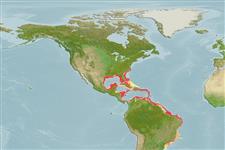Common names from other countries
Environment: milieu / climate zone / depth range / distribution range
Ecología
; rango de profundidad 1 - 151 m (Ref. 101602). Tropical; 35°N - 29°S, 98°W - 34°W
Western Atlantic and Western Central Pacific: From North Carolina and Bermuda, to Santa Catarina State, Brazil; Philippines.
Length at first maturity / Tamaño / Peso / Age
Maturity: Lm ? range ? - ? cm Max length : 9.0 cm SHL macho / no sexado; (Ref. 83435); common length : 11.0 cm SHL macho / no sexado; (Ref. 344)
Shell circular, inequivalve, lower valve strongly concave, upper valve flatter, slightly convex. Hinge with wing-like projections of equal size. Sculpture on upper (flat) valve of about 35 ribs and interspaces of about same width. Lower (deep) valve with about 20 less prominent ribs. Colour: tan to light brown. Inner surface of lower valve white. Upper valve mottled with reddish brown and dark brown markings.
Life cycle and mating behavior
Madurez | Reproducción | Puesta | Huevos | Fecundidad | Larva
Members of the class Bivalvia are mostly gonochoric, some are protandric hermaphrodites (Ref. 833). Species is a hermaphrodite exhibiting asynchronous reproduction. Spawning occurs during summer, autumn and spring. Protandric individuals dominate during spring time while proterogynous individuals dominate in summer and autumn (Ref. 93548). Life cycle: Embryos develop into free-swimming trocophore larvae, succeeded by the bivalve veliger, resembling a miniature clam (Ref. 833).
Leal, J.H. 2003. (Ref. 344)
IUCN Red List Status (Ref. 130435: Version 2024-1)
CITES status (Ref. 108899)
Not Evaluated
Not Evaluated
Human uses
Pesquerías: comercial
| FishSource |
Herramientas
Fuentes de Internet
Estimates based on models
Preferred temperature
(Ref.
115969): 22.9 - 28, mean 26.5 (based on 370 cells).
Vulnerability
Low vulnerability (10 of 100).
